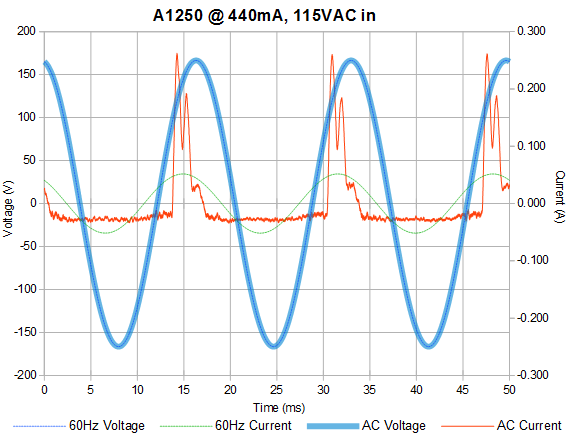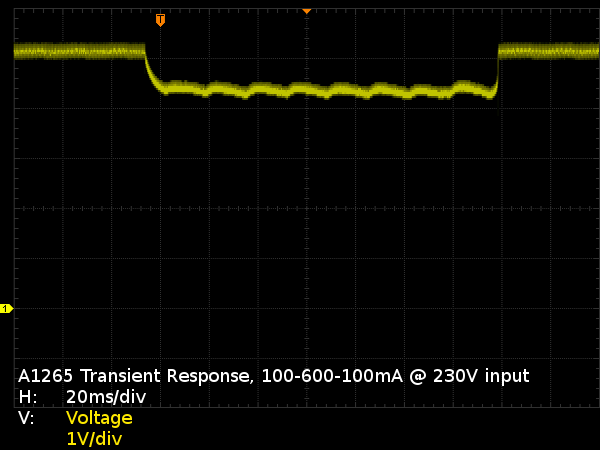Tom's Teardown: Two More Apple A1265 iPhone Charger Lookalikes
A1265 – Riding The Half-Wave
Instead of including a second input graph, I decided to comment on the adapter’s odd input current waveform. Since it uses a half-wave rectifier, the adapter sees input current only on one half-wave. The weirdest thing is that, rather than having triangular peaks when the input capacitor gets charged up, the decaying slope has two notches to it. Since the input capacitor depletes before the next peak, output voltage dips. When the capacitor gets topped up, the output overshoots, the oscillator shuts off, and the feedback loop doesn’t settle until past the AC peak.
If you happen to be wondering about standby power, the adapter draws 80mW at 115V and 46mW at 230V, making this the first time in my tear-downs that an adapter draws less standby power at 230V.
MORE: Apple 5W Adapter Knock-offs: The Colorful A1265 Teardown
MORE: 10 Inexpensive Automotive USB Adapters, Tested
A1265 – Output Noise Waveform
Just like the BDL1000, this A1265’s input capacitor does not hold a sufficient charge to maintain output voltage between AC peaks. The only difference here is that, although the capacitor is twice as large, it gets topped off half as often.
Had the A1265 had a full-bridge rectifier, its line-related low-frequency ripples under “heavy” load (relative to its 440mA maximum at 115V) would have been reduced from 400mV to about 50mV.
MORE: Apple 5W Adapter Knock-offs: The Colorful A1265 Teardown
Get Tom's Hardware's best news and in-depth reviews, straight to your inbox.
MORE: 10 Inexpensive Automotive USB Adapters, Tested
A1265 – Transient Response
Since this A1265 can’t deliver a paltry 500mA on 115V input, I decided to give it a helping hand by providing 230V. The adapter’s output dips by 900mV from barely being able to cope with the extra load with no apparent undershoot or overshoot.
Since even the most permissive version of the BC spec requires 4.4V at a minimum, 4.3V is 100mV short from meeting the absolute lowest standard. This “1A” adapter can’t even qualify as 600mA at 230V.
MORE: Apple 5W Adapter Knock-offs: The Colorful A1265 Teardown
MORE: 10 Inexpensive Automotive USB Adapters, Tested
A1265 – Short-Circuit Response
Our martyr suffers through a short-circuit condition by simply putting out whatever puny current it's capable of (approximately 800mA peak). While that may sound unsettling, keep in mind that 800mA at 200mV is only 160mW, a trivial amount of heat to get rid of. Assuming the circuit is reasonably well-tuned, I’d expect the output rectifier with its 0.5-0.6V forward voltage to be the hottest component in there. Recovery from short-circuit is sharp and clean.
MORE: Apple 5W Adapter Knock-offs: The Colorful A1265 Teardown
MORE: 10 Inexpensive Automotive USB Adapters, Tested
A1265 – Isolation Withstand Test
At 1370VAC, a single spark cracks across the ribbon cable wire tips instead of the pads as I originally predicted. Then the voltage collapses to ~600VAC, demonstrating that sharp points have much lower breakdown voltages than soft curves.
In all likelihood, the ceramic capacitor’s ratings were exceeded, and the extreme voltage and current change rates from the spark finished it off. Let’s knock it off the board and see if my guess is correct.
MORE: Apple 5W Adapter Knock-offs: The Colorful A1265 Teardown
MORE: 10 Inexpensive Automotive USB Adapters, Tested
A1265 – Uncapped Isolation Withstand Test
With the capacitor removed, how high can the voltage be cranked before something else fails? I was expecting the ribbon cable pads to spark over again at 1300-1500VAC and was surprised to pass 2230VAC before getting a board-level failure. My prediction on its location was slightly off, too. While still between the same two traces, it happened between component pads instead of ribbon pads.
After burning in for a little while, voltage across the fault settled at 200VAC.
MORE: Apple 5W Adapter Knock-offs: The Colorful A1265 Teardown
MORE: 10 Inexpensive Automotive USB Adapters, Tested
A1265 – Tracking
In the Colorful and BDL1000 adapters, arcs between traces burnt off the solder mask without leaving conductive residue behind, which let the boards maintain or even improve breakdown voltage. Here, though, burnt paint sputtered between the two pads and formed a black track that becomes conductive when given sufficiently high voltage.
This is exactly the sort of problem anti-tracking slots would prevent, or at least render highly improbable.
MORE: Apple 5W Adapter Knock-offs: The Colorful A1265 Teardown
MORE: 10 Inexpensive Automotive USB Adapters, Tested
A1265 – Transformer Isolation Withstand Test
Were you expecting another winding-to-winding arc failure? Nope, not this time. Here, due to the transformer terminals’ proximity to the ferrite core, arcs actually jump from one terminal on the primary side to the ferrite core and then to a secondary-side terminal.
How can this happen when ferrite isn’t generally considered conductive? As the name and its function imply, ferrite contains ferromagnetic materials like powdered iron with fillers and binders keeping those particles isolated to reduce high-frequency core losses. The densely packed particles act like tiny capacitors and will let some current through under alternating current.
MORE: Apple 5W Adapter Knock-offs: The Colorful A1265 Teardown
MORE: 10 Inexpensive Automotive USB Adapters, Tested
A1265 – Let The Sparks Fly
When considering potential transformer failures, terminal placement relative to the ferrite core wasn’t something I thought I’d run into at only 3245VAC and 60 Hz. But in this transformer’s case, the pins are inserted into the coil form about 0.5mm away from the core, which is much closer than any transformer I remember looking at. At least it made my twilight sparkle.
Now, let’s move on to some results.
MORE: Apple 5W Adapter Knock-offs: The Colorful A1265 Teardown
MORE: 10 Inexpensive Automotive USB Adapters, Tested
Efficiency
The BDL1000 barely beats Level V efficiency at 250mA on 115V and falls roughly 10% short across all test points at 230V. With efficiency below 60%, it is entirely possible that the transformer’s thin primary wiring failed from local overheating, even more so if the exposed wires got nicked during transformer or board assembly. That’s another good reason to double-insulate them.
This A1265 wannabee fares just about as poorly on 115V, under-delivering worse than the BDL1000. Efficiency actually gets decent at 400mA or so, where it beats Level VI requirement on 230V. However, its sharp cut-off at 590mA makes it a Pyrrhic victory.
MORE: Apple 5W Adapter Knock-offs: The Colorful A1265 Teardown











